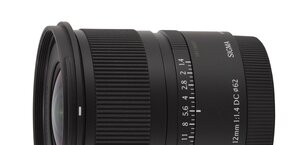Sigma A 24-105 mm f/4 DG OS HSM
8. Vignetting

Our measurements confirm that. At a difficult combination of the wide angle and the maximum relative aperture the vignetting is just 11% (-0.35 EV). What’s interesting, that value doesn’t change on stopping down.
Please Support UsIf you enjoy our reviews and articles, and you want us to continue our work please, support our website by donating through PayPal. The funds are going to be used for paying our editorial team, renting servers, and equipping our testing studio; only that way we will be able to continue providing you interesting content for free. |
- - - - - - - - - - - - - - - - - - - - - - - - - - - - - - - - - - - - - - - - - - - - - - - -
You deal with similar values at 45 mm focal length. At the maximum relative aperture the vignetting reaches 12% (-0.37 EV) and it decreases to 9% (-0.27 EV) by f/5.6. The situation changes just a little when you pass to 70 mm – by f/4.0 the vignetting is 13% (-0.42 EV) and it decreases to an imperceptible level of 8% (-0.23 EV) when you change the aperture value to f/5.6. Almost identical results you see at 105 mm where, at the maximum relative aperture, the brightness loss in the frame corners amounts to 13% (-0.41 EV) and then it decreases to 7% (-0.20 EV) on stopping down to f/5.6.
Significant physical dimensions, compared to those of the rivals, and the biggest diameter of the filter thread in the whole group seemed to suggest that the Sigma could fare better in the vignetting category on full frame than the Canon, the Nikkor or the tiny Sony 24-105 mm. Unfortunately the reality wasn’t in line with our expectations and the thumbnails, shown below, prove that much.

Already by f/4.0 and at 24 mm you can notice huge problems, with the light fall-off in the frame corners amounting to as much as 57% (-2.43 EV). Contrary to the performance observed on a small sensor here the vignetting decreases on stopping down but not as fast as we would wish it to. By f/5.6 that aberration reaches a level of 42% (-1.59 EV) and by f/8.0 it can be still considered huge because it gets near 31% (-1.06 EV). On further stopping down the improvement you notice is really small because by f/11 and by f/16 the vignetting remains 27-28%.
When you pass to 45 mm focal length you can notice a distinct improvement. At the maximum relative aperture the vignetting reaches 37% (-1.35 EV) and it decreases to 23% (-0.75 EV) when you change the aperture to f/5.6. On stopping down the lens to f/8.0 the vignetting level diminishes to 16% (-0.52 EV). Further stopping down doesn’t bring any measurable changes of that aberration’s level.
At 70 mm serious problems return – the vignetting at the maximum aperture gets to 54% (-2.24 EV). This time, however, the stopping down provides a bit better results than at the wide angle; by f/5.6 the vignetting is 32% (-1.13 EV) and by f/8.0 it reaches 20% (-0.64 EV). Still only by f/11 and f/16, where the brightness loss amounts to 12-14%, you can call this aberration’s level low.
A very similar situation can be observed at 105 mm focal length. By f/4.0 the vignetting level rises to a high value of 52% (-2.14 EV) and it decreases to 31% (-1.07 EV) on stopping down the lens to f/5.6. The aberration becomes low by f/8.0 (16%) and it disappears practically completely by f/11 (10%).
To sum up in this category we were a bit disappointed. The Sigma is physically bigger than the Nikkor 24-120 mm VR and it comes with a narrower range of focal lengths; still its vignetting results are worse. It is nothing to be proud of.
 |
 |
 |
 |






